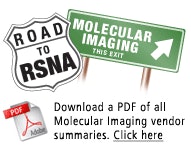In the past several years, molecular imaging has emerged as arguably the most exciting and promising modality in medical imaging. With the promise of personalized therapies for treating a variety of diseases and conditions, molecular imaging is capturing the imagination of some of the brightest minds in healthcare.
The advance of instrumentation and software will take a prominent role in propelling near-term opportunities for molecular imaging, and the next 20 years will see techniques "increase toward natural metabolic or natural molecular imaging, where we will view functional images in a metabolic context."

Another issue at the forefront today is reimbursement coverage by the U.S. Centers for Medicare and Medicaid Services for more oncology PET applications. Expanded reimbursement may be on the horizon, as the agency recently agreed to reconsider adding coverage for more cancers, thanks to findings from the National Oncologic PET Registry that show PET influences care management for one-third of cancer patients.
Of immediate concern within the molecular imaging community is the shortage of medical isotopes due to the current closure of a nuclear reactor in the Netherlands. The temporary shutdown, now scheduled to last until February 2009, followed the temporary loss of production at the Canadian Chalk River reactor two months earlier.
The molecular imaging industry advocates the construction or conversion of more sites, especially in the U.S., to accommodate worldwide demand and cover any unexpected supply shortfalls, but additional medical isotope production appears to be years from coming online.
Still, there is reason for optimism within the community. As SNM President Robert Atcher, Ph.D., stated at the society's annual meeting, "We are on the brink of an incredible new opportunity to provide the right patient with the right drug at the right time. With molecular imaging, doctors can quickly know how effective the treatment is, allowing them to target treatment more accurately and often more successfully. This is the promise of personalized medicine."
Expect more promising developments in molecular imaging at this year's RSNA meeting in Chicago. Below are some highlights you can expect.




















